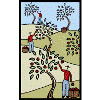Agricultural Economics, Department of
ORCID IDs
Document Type
Article
Date of this Version
10-30-2007
Abstract
Intellectual property rights for crop plant material should in principle increase social welfare by increasing private research investments to a level closer to the social optimum. In the US, plant patents were first introduced in 1930 by legislation that applied only to asexually reproduced plants. This was followed in 1970 by the weaker plant breeders' rights legislation (PBR) for sexually reproduced plants. Judicial decisions in 1980 and 1985, however, extended much stronger utility patent protection to plant materials. Here we examine theoretical welfare implications of weak PBR vs strong utility patents in a North-South context of technology transfer in agriculture and in the particular case of durable crop traits. The results suggest that PBR owners could obtain only 20% of the royalties that would be available to them with patent protection, PBR institutions may thus be too weak in general to stimulate socially optimal levels of new plant technology in the North. On the other hand, consumers would obtain three times the benefits under PBR as compared to patents. PBR may provide sufficient incentive to stimulate technology transfers to the South and might be the preferred IP institution.



Comments
Chapter 6 in E.C.Teixeira and M.J. Baga (eds.), Institutions and Economic Development, Vicosa, MG, Brasil, Os Editores, 2007, pp 171-192.